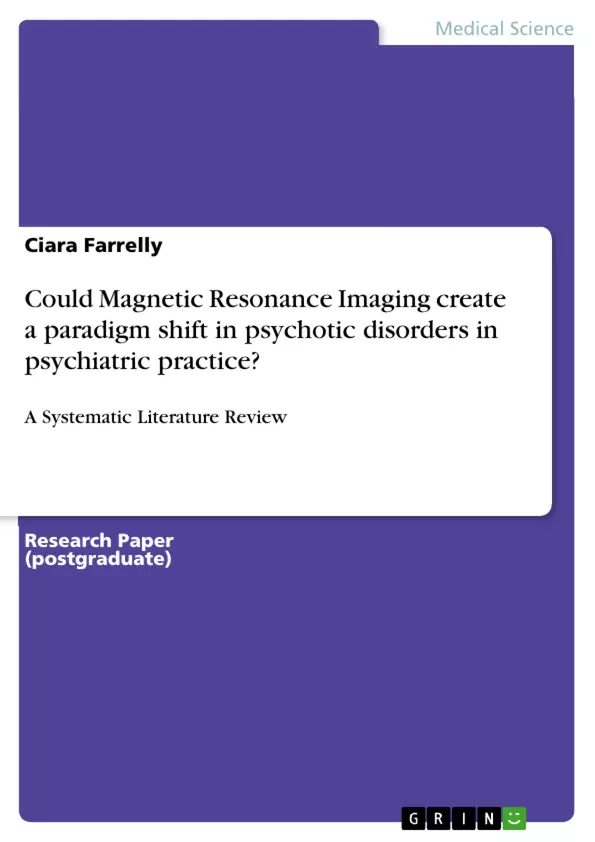This project aimed to ascertain whether Magnetic Resonance Imaging (MRI) could create a paradigm shift in psychiatric practice for psychotic disorders. Psychotic disorders are mental illnesses that are characterised by hallucinations and delusions, with disturbances to the thinking process, insight, and judgement of the individual. A prompt and accurate diagnosis for psychoses is critical for effective patient management, treatment and subsequently, patient outcomes. Unlike most diseases, there are presently no reliable biomarkers that offer a definitive diagnosis for psychoses.
The current symptom-based approach and is hindering the effectiveness of diagnosis due to validity and reliability issues. As psychoses are classified based upon clinical presentation, the diagnosis between brain disease, trauma and different psychotic disorders become blurred. Research from this project has suggested the potential use of structural and functional MRI techniques in determining a biomarker to overcome these issues.
Psychoses are classified as either organic or functional. Organic psychoses are characterised by brain abnormalities that are induced by physical defects including brain trauma or illnesses, such as Alzheimer’s disease. Substance abuse can also generate psychosis. However, brain function that precipitates delusions and hallucinations are more frequently associated with specific psychiatric disorders, categorised as functional psychoses which incorporates schizophrenia and mood disorders, such as Bipolar Disorder (BD). The World Health Organisation (WHO) (2001) acknowledged schizophrenia as the most common of the psychoses, affecting 21 million people worldwide.
Table of Contents
- Chapter One: Introduction
- 1.1 Introduction
- 1.2 Background
- 1.3 Aetiology
- 1.4 Current Diagnosis
- 1.5 Psychoradiology
- 1.6 Rationale
- 1.7 Project question
- 1.7.1 Hypothesis
- 1.7.2 Null Hypothesis
- 1.8 Aims
- 1.9 Objectives
- 1.10 Summary
- Chapter Two: Methodology
- 2.1 Introduction
- 2.2 The Nature of a Literature Review
- 2.3 Research Design
- 2.3.1 Alternative Project Methods
- 2.4 Rationale for Systematic Literature Review
- 2.5 Sources of Information
- 2.6 Search Strategy
- 2.6.1 Search Technique
- 2.6.2 Search Terms
- 2.6.3 Search Criteria
- 2.7 Critical Evaluation of Literature
Objectives and Key Themes
This project aimed to investigate the potential of Magnetic Resonance Imaging (MRI) to revolutionize psychiatric practice for psychotic disorders. The study aimed to determine if MRI could provide a reliable biomarker for diagnosis, thereby improving the accuracy and effectiveness of treatment.
- The use of MRI as a potential biomarker for diagnosing psychotic disorders.
- The identification and characterization of structural and functional brain changes associated with psychotic disorders.
- The potential of MRI to improve the understanding of the pathophysiology of psychosis.
- The limitations of current MRI techniques and the need for further research to translate findings into clinical practice.
- The potential for MRI to differentiate between different types of psychotic disorders, leading to more accurate diagnoses and treatment.
Chapter Summaries
Chapter One provides a comprehensive introduction to the project, outlining the background information on psychotic disorders and the current diagnostic practices. This chapter delves into the aetiology of psychosis and explores the emerging field of Psychoradiology, highlighting the role of MRI in understanding brain structure and function. The chapter concludes by defining the project question, hypothesis, and objectives.
Chapter Two outlines the methodology employed in the project, focusing on the systematic literature review approach. It discusses the rationale for this approach, explores the sources of information used, and details the search strategy and criteria employed to identify relevant studies. The chapter concludes by discussing the critical evaluation process used to assess the quality of the literature.
Keywords
This project focuses on the use of MRI as a potential biomarker for diagnosing psychotic disorders. The key themes explored include structural and functional brain changes, pathophysiology of psychosis, diagnosis and treatment of psychotic disorders, and the limitations of current MRI techniques.
- Arbeit zitieren
- Ciara Farrelly (Autor:in), 2019, Could Magnetic Resonance Imaging create a paradigm shift in psychotic disorders in psychiatric practice?, München, GRIN Verlag, https://www.grin.com/document/492192



